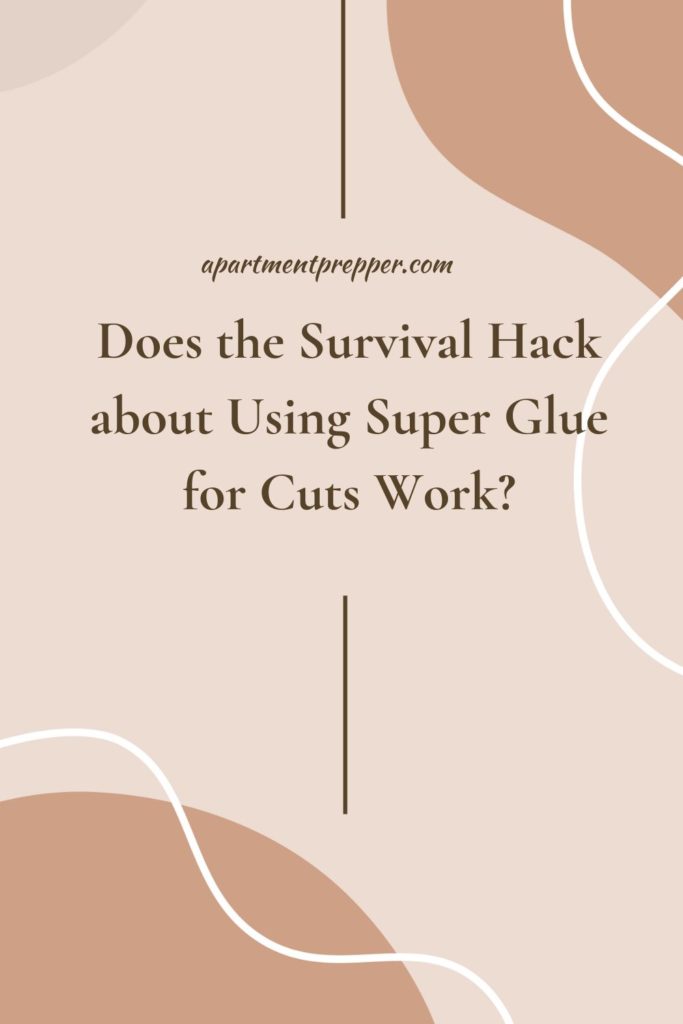Have you ever heard about the survival hack of using super glue for cuts? It’s a trick that has been passed around for years, but does it really work? In this blog post, we’ll explore the pros and cons of using super glue for cuts and look at whether this hack can actually be an effective way to stop bleeding and help heal wounds. Read on to find out if the super glue survival hack is worth trying out.
What is the Super Glue Survival Hack?
The Super Glue Survival Hack is a survival technique (popularly used in wilderness survival scenarios) that suggests using super glue to close a cut or wound. This hack has become more popular over the years as a quick, cheap, and easy first aid method to help stop bleeding from minor cuts in order to prevent infection and the spread of bacteria. It has been seen as a viable alternative to using medical tape or stitches to close a wound.
(Note: This article is not written by a medical professional. It is for informational purposes only and should not be taken as medical advice.)
Does it Really Work?
The short answer to this question is yes – the super glue hack does work for minor cuts and abrasions. Super glue is an adhesive made of cyanoacrylate. It is often used in industrial and craft projects for its strength and fast drying time. Because it is waterproof and bonds almost immediately, it can be used to seal very small cuts and reduce the risk of infection. Super glue is primarily used for closing small lacerations, such as cuts from paper, glass, razors, and scissors. It is also used on skin abrasions and blisters. When used properly, super glue can help to seal off the edges of a wound and prevent further damage, while providing a protective barrier against bacteria. In addition, it can also reduce pain and promote faster healing. However, using super glue for cuts should only be done as a last resort, when seeking professional medical care is not an option. Furthermore, it’s important to be aware of any possible risks associated with using super glue on cuts or wounds.
What Are the Risks of Using Super Glue for Cuts?
It is important to consider the risks before trying this hack. First and foremost, it is important to understand that the adhesive properties of super glue is not meant to be used on skin and can cause skin irritation or an allergic reaction in some individuals. For this reason, it is important to test a small patch of skin before using it on larger cuts. It can also cause a burning sensation. Additionally, if the glue is applied too heavily or too close to a large vein, it can potentially cause blockage and further complications.
When used on an open wound, the glue can stick to skin cells, creating a painful burning sensation. The glue can also trigger an allergic reaction or infection, which can delay healing and increase the risk of scarring. In addition, super glue isn’t intended to be used on deep cuts, since it won’t bond the tissue together in the same way that sutures or medical adhesives would. The glue could actually make the cut worse by trapping bacteria in the wound and making it more difficult for the body to heal itself.
Finally, using super glue as a temporary fix instead of seeking medical attention can be dangerous. If your cut is deep or accompanied by signs of infection (such as swelling, redness, or pus), you should visit a doctor immediately.
It is important to note that super glue should only be used for minor cuts and scrapes. If you have a deep cut or any type of open wound, then it is recommended that you seek professional medical advice.
Tips for Using the Super Glue on Cuts
Using super glue to close up a wound can seem like a great idea, but it should not be done without medical advice. It is a simple and easy way to treat minor cuts, but it is important to follow the proper steps to ensure you are doing it safely.
Remember that super glue should not be used on wounds that are actively bleeding. Additionally, the glue should not be used on the face or any area that has an underlying infection or is prone to infection.
First, make sure the wound is cleaned of any dirt or debris and the area is clean and dry. If needed, rinse the area with clean water and gently pat dry with a clean cloth or gauze. You can use an antiseptic to help reduce the risk of infection.
If there are any particles in the wound, remove them before applying the glue. Once the wound is clean, apply a thin layer of super glue to the area. The glue should be applied in a straight line over the wound and should not be too thick. Do not spread the glue outside of the cut.
The skin should also be pulled together as much as possible before applying the glue. Once the glue has been applied, let the glue dry for a few minutes before applying pressure on the wound. This will help to ensure that the glue holds the skin together.
Once the super glue has dried, it should be kept covered with a bandage to help protect it from dirt and bacteria. It’s important to keep the wound clean and dry until it has healed completely. Change the bandage regularly and keep an eye out for any signs of infection such as swelling, redness, or pus. After you have applied it, do not scratch or pick at the wound, and do not use antibiotic ointment over the glue as it will dissolve it, according to the Mayo Clinic.
What to Use for Wounds Instead of Super Glue
When treating a wound, it’s important to consider the best method of treatment that will promote healing and avoid infection. There are safer alternatives that offer better protection for wounds.
Medical grade super glue is specifically designed for use on skin to close wounds. These glues are different from regular super glues because they contain additional ingredients, such as antibacterial agents, that make it safe for use on skin, help prevent infection, and are less likely to cause skin reactions than standard super glue. The active ingredient is ethyl cyanoacrylate, which rapidly polymerizes to form a flexible seal over the wound. Examples include:
Epiglu
Dermabond
SurgiSeal
Histoacryl
Indermil
GluStitch
GluSeal
LiquiBand
Another alternative is liquid bandage, such as New Skin, which seals wounds and forms a protective waterproof barrier on scrapes and minor cuts. Be aware that they can cause a burning sensation when applied.
When used correctly, medical grade super glue can be used to close minor cuts and lacerations. However, due to its strong adhesive properties, it should not be used to treat deeper or larger wounds, or those with active bleeding. In addition to being safer than regular super glues, medical grade super glue is also more effective at sealing wounds due to its fast-acting properties. It is also easier to use than traditional suturing techniques, which requires more skill and precision. Although medical grade super glue is typically safe and effective when used properly, there are some risks associated with its use. The most common side effect is skin irritation, which is usually caused by an allergic reaction or sensitivity to the adhesive. Additionally, overuse of medical grade super glue can cause skin discoloration, swelling, or even burning. For these reasons, it is important to follow the instructions carefully and only use the glue in small amounts when treating minor wounds.
When it comes to using super glue for cuts, it’s always best to talk to a doctor or healthcare professional first. They can provide advice on how to use the glue safely and effectively, and whether or not it’s the right choice for your particular situation.
In conclusion, using super glue in an emergency, when you have nothing else, can work on certain types of wounds such as minor cuts. It is not to be used on deep wounds, puncture wounds, burns, jagged wounds, animal bites, open, and large wounds. Instead of planning to improvise, it would be a good idea to add a liquid bandage, such as New Skin to your first aid kit.
If you found this article interesting or helpful, please consider helping us out (without costing you anything)! We are an affiliate of Amazon.com, which means we received a small commission if you click through one of our Amazon links when you shop, at totally no cost to you. This helps keep the lights on at the blog. Thanks!


